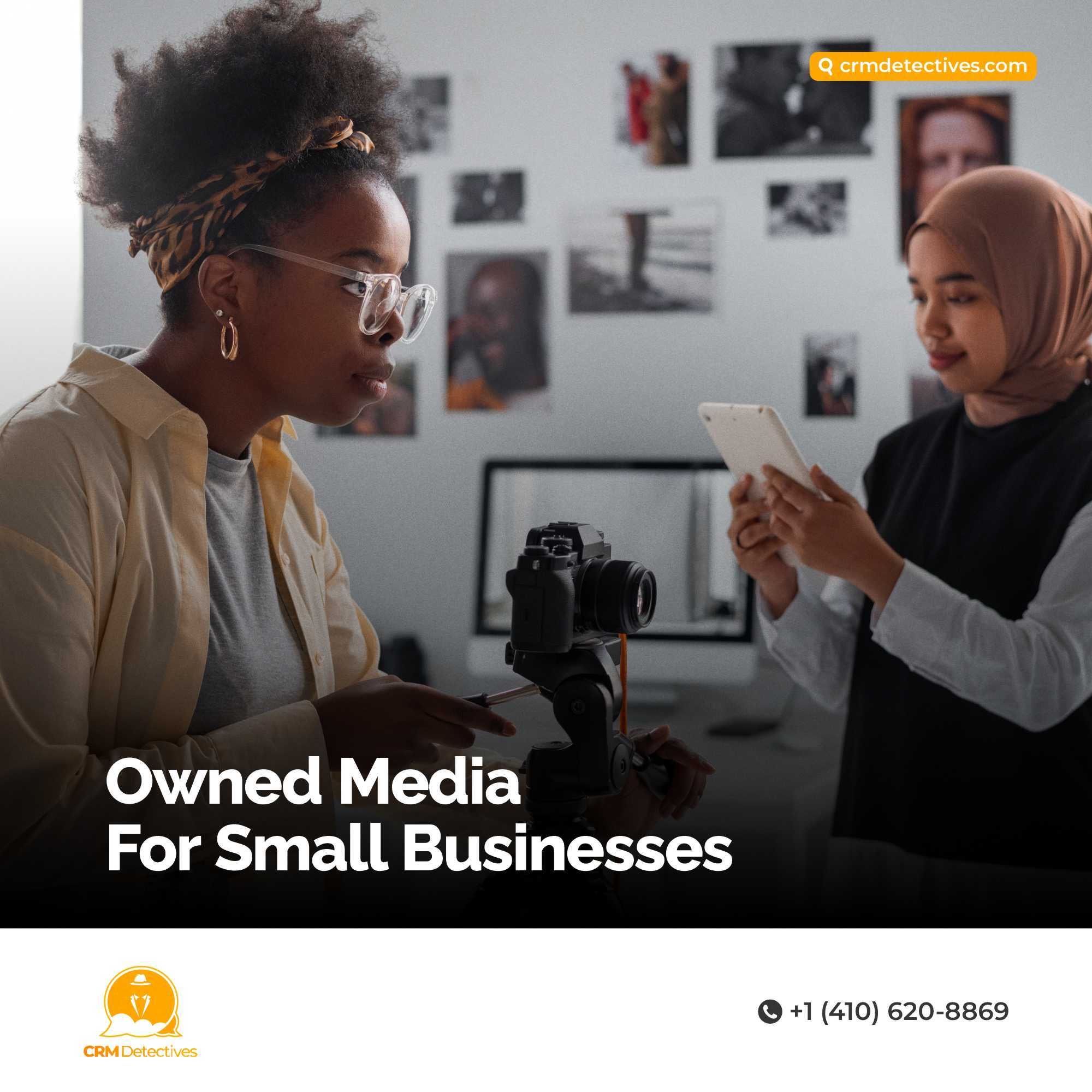Owned media refers to all the marketing channels that your business fully controls, including your website, blog, email list, social media accounts, and any other platforms where you create and distribute content without paying for advertising space. Unlike paid advertising that stops working when you stop paying, or social media algorithms that can limit your reach, owned media provides a foundation for long-term marketing success that belongs entirely to your business.
Think of owned media like owning your own house versus renting an apartment. When you rent, you are at the mercy of the landlord’s rules and can be forced to move at any time. When you own your home, you control the environment, make the rules, and build equity that belongs to you forever. Similarly, owned media gives you complete control over your marketing message and builds valuable assets that strengthen your business over time.
Understanding owned media is crucial for small businesses because it provides the most cost-effective way to reach customers, build lasting relationships, and create marketing assets that compound in value over time. While paid advertising can deliver quick results, owned media creates sustainable competitive advantages that become more valuable as your audience grows and your content library expands.
Summary
Owned media includes your business website, blog content, email marketing lists, social media profiles, podcasts, videos, downloadable resources, and any other content platforms that you control completely. These channels allow you to communicate directly with your audience without depending on external platforms or paying for each interaction.
Key benefits include complete control over messaging and timing, direct relationships with customers, cost-effective long-term marketing, improved search engine visibility, and the ability to build valuable business assets that appreciate over time. Owned media also provides data and insights about your customers that you cannot get from rented marketing channels.
Success with owned media requires consistent content creation, strategic distribution across multiple channels, focus on providing genuine value to your audience, and patience to build audience and authority over time. The investment in owned media pays off through increased customer loyalty, higher conversion rates, and reduced dependence on expensive paid advertising.
Building Your Business Website Foundation

Your business website serves as the cornerstone of your owned media strategy, providing a central hub where potential customers can learn about your business, explore your offerings, and take action to become customers or clients.
Professional web presence establishes credibility and trust with potential customers who expect legitimate businesses to have functional, informative websites. A well-designed website signals that your business is established, professional, and serious about serving customers effectively.
Search engine optimization opportunities allow your website to attract organic traffic from people searching for products or services like yours. Quality content, proper site structure, and strategic keyword usage help your website rank higher in search results, bringing qualified visitors without ongoing advertising costs.
Lead capture mechanisms like contact forms, newsletter signups, and resource downloads help convert website visitors into potential customers you can market to directly. These tools turn anonymous website traffic into valuable contact information for your email marketing efforts.
Content marketing platform capabilities allow you to publish blog posts, articles, guides, and other valuable content that attracts visitors and establishes your expertise. Regular content publication improves search engine rankings while providing reasons for people to visit and revisit your website.Customer service functions include contact information, frequently asked questions, product specifications, pricing details, and other information that helps customers make purchasing decisions without requiring direct contact with your business.
Analytics and tracking tools provide detailed insights about your website visitors, including where they come from, what pages they visit, how long they stay, and what actions they take. This data helps you optimize your website and content strategy for better results over time.
Mobile responsiveness ensures your website works well on smartphones and tablets, which is essential since most people now browse the internet primarily on mobile devices. Mobile-friendly websites also rank better in search engines and provide better user experiences.
Content Marketing Strategy

Content marketing through owned media channels helps attract and engage your target audience by providing valuable information that addresses their questions, solves their problems, and builds trust in your expertise and business capabilities.
Blog content creation allows you to publish regular articles that attract search engine traffic, demonstrate your knowledge, and provide reasons for people to visit your website repeatedly. Blog posts can cover industry topics, answer customer questions, share case studies, and provide helpful guides.
Video content development can include product demonstrations, educational tutorials, behind-the-scenes content, customer testimonials, and other engaging formats that work well across multiple owned media channels including your website, email newsletters, and social media profiles.
Resource creation involves developing downloadable guides, checklists, templates, worksheets, and other valuable materials that visitors will exchange their contact information to obtain. These lead magnets help build your email list while providing immediate value to potential customers.
Content calendar planning helps you maintain consistent publishing schedules across all your owned media channels, ensuring regular engagement with your audience and steady growth in search engine visibility and customer relationships
Repurposing strategies allow you to create multiple content pieces from single ideas, maximizing the value of your content creation efforts. A single blog post might become multiple social media posts, an email newsletter, a video script, and sections of a downloadable guide.
Audience-focused approach means creating content that serves your target customers’ needs rather than just promoting your business. Educational content, problem-solving guides, and industry insights typically perform better than purely promotional material.
SEO integration involves incorporating relevant keywords naturally into your content while focusing on providing genuine value to readers. Content that ranks well in search engines brings qualified traffic that converts better than most other marketing channels.
Email Marketing and List Building

Email marketing represents one of the most valuable owned media assets because you can communicate directly with people who have expressed interest in your business, without depending on social media algorithms or search engine changes.
List building strategies focus on attracting email subscribers through valuable content offers, exclusive deals, newsletters with useful information, and other incentives that make people want to hear from your business regularly.
Segmentation approaches allow you to divide your email list into groups based on interests, purchase history, demographics, or behavior, enabling more targeted and effective email campaigns that generate better responses and higher conversion rates.
Newsletter content can include industry news, helpful tips, exclusive offers, behind-the-scenes content, customer spotlights, and other valuable information that keeps subscribers engaged and looking forward to your emails.
Automation sequences help nurture new subscribers by sending series of emails that introduce your business, provide valuable information, and guide people toward making purchases or taking other desired actions without requiring manual work for each subscriber.
Personalization techniques make emails feel more relevant and engaging by using subscriber names, referencing their interests or previous interactions, and tailoring content to their specific needs and preferences.
Performance tracking allows you to monitor open rates, click-through rates, conversion rates, and other metrics that help you understand what types of content resonate with your audience and optimize future campaigns for better results.
Mobile optimization ensures your emails look good and function properly on smartphones and tablets, which is essential since most people check email primarily on mobile devices.
Social Media as Owned Assets

While social media platforms are technically third-party services, your business profiles and the communities you build around them represent valuable owned media assets that provide direct access to your audience.
Profile optimization involves creating complete, professional profiles with consistent branding, compelling descriptions, relevant keywords, and clear calls-to-action that help potential customers understand what your business offers and how to take next steps.
Community building focuses on attracting and engaging followers who are genuinely interested in your business rather than just accumulating large numbers of followers who do not engage with your content or convert to customers.
Content strategy for social media should balance promotional posts with valuable, educational, and entertaining content that encourages engagement, sharing, and relationship building with your audience over time.
Engagement tactics include responding to comments and messages promptly, asking questions that encourage responses, sharing user-generated content, and participating in relevant conversations within your industry or local community.
Cross-platform promotion helps you leverage each social media channel’s strengths while driving traffic between platforms and ultimately back to your website where you have more control over the customer experience and conversion process.
Analytics utilization involves tracking engagement metrics, reach, click-through rates, and conversion data to understand which types of content and posting strategies work best for your specific audience and business goals.
Relationship development through consistent, authentic interaction helps turn social media followers into genuine business relationships that can lead to customer referrals, partnerships, and long-term business growth beyond direct sales.
Video and Podcast Content

Video and podcast content represent powerful owned media formats that can build strong connections with your audience while establishing your expertise and personality in ways that written content cannot match.
Video content types include educational tutorials, product demonstrations, customer testimonials, behind-the-scenes content, live streams, and recorded presentations that showcase your knowledge and help potential customers understand your business better.
Production quality considerations balance professional appearance with authenticity and budget constraints. While high production values can be impressive, consistent, helpful content often matters more than perfect video quality for small business marketing.
YouTube channel development provides a platform for hosting and distributing your video content while potentially attracting new audiences through YouTube’s search and recommendation features. YouTube also serves as a valuable source of website traffic and lead generation.
Podcast creation allows you to share in-depth knowledge, interview industry experts, discuss relevant topics, and build relationships with listeners who appreciate the convenience and personal nature of audio content.
Content distribution strategies ensure your video and audio content reaches your audience through multiple channels including your website, email newsletters, social media profiles, and third-party platforms that can expand your reach.
SEO benefits from video and podcast content include improved search engine rankings, increased time spent on your website, and additional opportunities to target relevant keywords and topics that attract qualified traffic.
Audience engagement through video and audio content often exceeds written content because these formats feel more personal and allow your personality and expertise to come through more clearly than text-based communication.
Creating Valuable Resources and Downloads

Downloadable resources serve dual purposes by providing immediate value to your audience while capturing contact information that allows you to continue marketing to interested prospects through email and other owned media channels.
Lead magnet development involves creating guides, checklists, templates, worksheets, or other resources that address specific problems your target customers face, providing enough value that people willingly share their contact information to access them.
Content formats can include PDF guides, video tutorials, audio recordings, spreadsheet templates, design assets, or any other digital resources that your audience would find valuable and relevant to their needs or interests.
Landing page creation provides dedicated web pages that promote your downloadable resources, explain their benefits, and include contact forms that capture subscriber information in exchange for access to the materials.
Email delivery systems automatically send download links to new subscribers while adding them to your email list for ongoing marketing communications, creating an efficient process that works without manual intervention.
Follow-up sequences help nurture people who download your resources by sending additional valuable content, introducing your paid services or products, and building relationships that can lead to customer conversions over time.
Content upgrades involve creating specific resources that complement your blog posts or other content, encouraging readers to subscribe for additional related materials that expand on the topics they are already interested in.
Resource libraries on your website can house collections of valuable downloads, creating destinations that attract visitors and encourage them to explore multiple resources while building your email list through various opt-in opportunities.
Measuring Owned Media Success

Tracking the performance of your owned media efforts helps you understand what works, what needs improvement, and how to allocate your time and resources for maximum impact on your business growth.
Website analytics provide insights into visitor behavior, traffic sources, popular content, conversion rates, and other metrics that help you understand how well your website serves your business goals and where improvements might be needed.
Email marketing metrics include open rates, click-through rates, conversion rates, list growth, and subscriber engagement levels that show how effectively your email campaigns build relationships and drive business results.
Content performance tracking helps you identify which blog posts, videos, resources, and other content pieces generate the most traffic, engagement, and conversions, allowing you to focus on creating more of what works best.
Social media analytics show engagement rates, reach, follower growth, and click-through rates to your website, helping you understand which platforms and content types provide the best return on your time investment.
Lead generation measurement tracks how many potential customers you attract through various owned media channels, the quality of those leads, and their conversion rates to actual customers or clients.
Cost per acquisition calculations help you understand the true cost-effectiveness of your owned media efforts by comparing the time and money invested against the number of customers gained through these channels.
Long-term growth tracking shows how your owned media assets appreciate in value over time through increased search engine rankings, larger email lists, more engaged social media followings, and improved conversion rates.
Integrating Owned Media Channels

Successful owned media strategies coordinate multiple channels to work together synergistically, creating a comprehensive marketing system that maximizes the impact of your content creation and audience building efforts.
Cross-channel promotion involves sharing content across multiple owned media platforms, driving traffic between your website, email list, and social media profiles to maximize the reach and impact of each piece of content you create.
Content repurposing allows you to adapt single pieces of content for multiple channels, turning blog posts into social media content, email newsletters, video scripts, and downloadable resources that serve different audience preferences and consumption habits.
Audience development strategies coordinate your efforts across all channels to build larger, more engaged audiences that provide multiple touchpoints for potential customers to discover and connect with your business.
Message consistency ensures that your branding, value proposition, and key messages remain consistent across all owned media channels while adapting the format and style to suit each platform’s audience expectations.
Data integration involves combining analytics and insights from all your owned media channels to develop comprehensive understanding of your audience behavior, preferences, and conversion patterns across their entire customer journey.
Automation opportunities help streamline the management of multiple owned media channels through tools and systems that can schedule content, trigger email sequences, and coordinate marketing activities with less manual work.
Strategic coordination ensures that your owned media channels support your overall business goals rather than operating as isolated marketing activities, creating cohesive customer experiences that guide prospects toward becoming customers.
Conclusion
Owned media provides small businesses with powerful, cost-effective marketing tools that build long-term value and competitive advantages that compound over time. Unlike paid advertising that requires continuous investment for ongoing results, owned media assets become more valuable as they grow and mature.
The key to owned media success lies in consistent effort, focus on providing genuine value to your audience, and strategic integration of multiple channels that work together to achieve your business goals. Start with one or two channels that match your strengths and audience preferences, then expand as you gain experience and see results.
Remember that owned media is a long-term strategy that requires patience and persistence to show significant results. However, the businesses that commit to building strong owned media foundations often find they become less dependent on expensive paid advertising while developing stronger customer relationships and more predictable growth.
Begin building your owned media strategy today by focusing on creating valuable content for your target audience, capturing contact information through helpful resources, and maintaining consistent communication that builds trust and positions your business as the preferred solution for your customers’ needs.
FAQs
Question 1: How long does it take to see results from owned media marketing?
Answer: Owned media typically requires 6-12 months of consistent effort before showing significant results, though you may see some benefits sooner. Blog content can start ranking in search engines within 3-6 months, email lists begin generating leads immediately but grow substantially over time, and social media followings usually build gradually over many months. The key is consistency and patience, as owned media results compound over time and become more valuable the longer you maintain your efforts.
Question 2: Which owned media channel should I focus on first as a small business?
Answer: Start with a professional website and blog if you do not already have them, as these provide the foundation for all other owned media efforts. Next, focus on building an email list since email marketing typically provides the highest return on investment for small businesses. Choose one social media platform where your target customers are most active rather than trying to manage multiple platforms initially. You can expand to additional channels once you have mastered the basics and seen results from your initial efforts.
Question 3: How much time should I spend on creating content for owned media?
Answer: Most successful small businesses dedicate 5-10 hours per week to content creation and owned media management, though this can vary based on your business size and marketing goals. Start with what you can sustain consistently - it is better to publish one quality blog post per week than to attempt daily posting and burn out after a few weeks. Focus on creating valuable content that serves your audience rather than just producing large quantities of mediocre content.
Question 4: Do I need professional help to manage my owned media, or can I do it myself?
Answer: Many small businesses successfully manage owned media themselves, especially in the beginning when budgets are tight and audience sizes are smaller. Basic website management, blog writing, email marketing, and social media posting can be learned and managed by most business owners. Consider professional help as your business grows and you need more sophisticated strategies, have budget for external expertise, or find that content creation takes too much time away from other business activities.
Question 5: How do I measure the return on investment from owned media efforts?
Answer: Track both leading indicators (website traffic, email subscribers, social media followers) and business results (leads generated, sales conversions, customer acquisition costs) to measure owned media ROI. Use free tools like Google Analytics for website tracking and built-in analytics from email and social media platforms. Calculate the customer lifetime value from owned media channels and compare it to the time and money invested. Remember that owned media builds long-term assets, so consider both immediate returns and cumulative value over time when evaluating success.

In my own marketing journey, I’ve discovered the real power of owned media. Paid campaigns gave me fast wins, but they always ended as soon as the budget did. With owned media, I’m building something lasting — my own website, my own email list, and content that keeps compounding in value. It’s a shift in mindset for me, moving from chasing quick results to creating sustainable platforms I control. That’s where I see the true long-term growth for myself and my business.